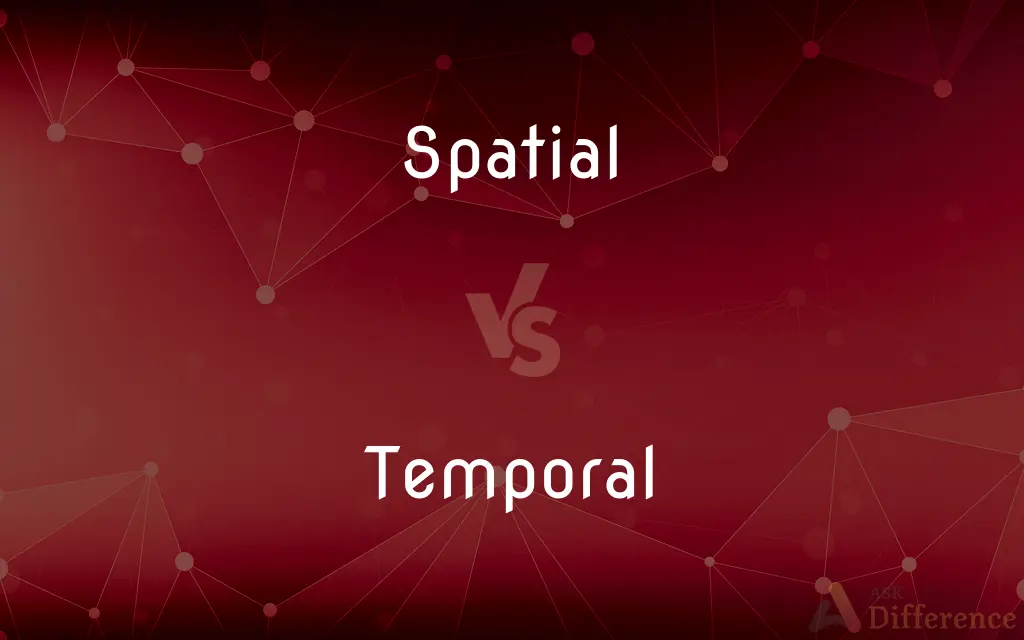Spatial vs. Temporal — What's the Difference?
Edited by Tayyaba Rehman — By Urooj Arif — Updated on February 26, 2024
Spatial relates to space and the arrangement of objects within it, while temporal pertains to time and the sequencing of events or moments.

Difference Between Spatial and Temporal
Table of Contents
ADVERTISEMENT
Key Differences
Spatial aspects focus on the configuration, dimensions, and locations of objects in space, emphasizing how these objects are positioned relative to one another. This concept is fundamental in fields like geography, architecture, and art, where the understanding of space and spatial relationships is crucial. Temporal, on the other hand, deals with the progression of time, durations between events, and the timing of activities. It plays a significant role in history, scheduling, and the sciences, where sequences, durations, and historical contexts are essential.
The spatial perspective helps us comprehend the physical layout of environments, guiding how we navigate and organize spaces. It's about understanding the "where" of things. Temporal analysis, conversely, helps us understand the "when," providing insight into changes over time, patterns of behavior, and the sequence of historical events. While spatial arrangements are static or dynamic within the constraints of physical dimensions, temporal arrangements are inherently about change, progression, and the rhythm of occurrences.
Spatial intelligence is employed in designing efficient layouts, urban planning, and creating art that utilizes physical space effectively. Temporal intelligence, however, is utilized in planning schedules, understanding historical trends, and in the study of rhythms in music or biological cycles, indicating how events unfold over time.
Intersecting spatial and temporal dimensions can lead to a more holistic understanding of phenomena. For example, in environmental studies, spatial distribution of resources and their temporal changes due to climate patterns are considered together. Similarly, in technology, spatial computing combines with temporal data to create dynamic models and simulations that reflect real-world changes over time.
Comparison Chart
Definition
Relating to space and the arrangement of objects within.
Pertaining to time and the sequencing of events.
ADVERTISEMENT
Focus
Configuration and location.
Sequences, durations, and timing.
Applications
Geography, architecture, urban planning.
History, scheduling, sciences.
Key Concepts
Layout, distance, direction.
Chronology, duration, rhythm.
Practical Use
Designing spaces, navigating environments.
Planning schedules, understanding historical contexts.
Compare with Definitions
Spatial
Pertaining to geography and locations.
Spatial data helps in mapping natural resources.
Temporal
Concerning the timing and sequence of events.
Temporal planning is essential in project management.
Spatial
Focused on distances and orientations.
Spatial intelligence aids in navigating complex environments.
Temporal
Focused on durations and intervals.
Temporal gaps in data can challenge researchers.
Spatial
Concerning the arrangement of objects in space.
Spatial awareness is crucial for architects.
Temporal
Related to the passage of time.
Temporal changes in climate can affect ecosystems.
Spatial
Related to the visual and physical environment.
Artists consider spatial relationships in compositions.
Temporal
Involving historical periods and chronology.
Temporal analysis can reveal patterns in historical events.
Spatial
Involving the physical layout and dimensions.
The spatial distribution of parks influences urban livability.
Temporal
Pertaining to rhythms and cycles.
Music relies on temporal patterns to create rhythm.
Spatial
Relating to or occupying space
The spatial distribution of population
Temporal
(relational) Relating to time:
Spatial
Of, relating to, involving, or having the nature of space.
Temporal
Of limited time, transient, passing, not perpetual, as opposed to eternal.
Spatial
Of or pertaining to space.
Temporal
Of or relating to time as distinguished from space.
Spatial
Pertaining to or involving or having the nature of space;
The first dimension to concentrate on is the spatial one
Spatial ability
Spatial awareness
The spatial distribution of the population
Temporal
Of or relating to the sequence of time or to a particular time.
Common Curiosities
What is the main difference between spatial and temporal?
Spatial relates to space and arrangements within it, while temporal concerns time and the sequencing of events.
Why is temporal understanding important?
Temporal understanding is crucial for planning, historical analysis, and recognizing patterns and trends over time.
How do spatial concepts apply in daily life?
Spatial concepts apply in navigation, arranging living and workspaces, and understanding maps and layouts.
Can spatial and temporal be considered opposites?
Not opposites, but distinct dimensions of analysis focusing on different aspects of reality: space and time.
Are there disciplines that combine spatial and temporal studies?
Yes, disciplines like environmental science, geography, and urban planning often analyze spatial and temporal data together.
How do computers utilize spatial and temporal data?
Computers use spatial data for mapping and simulations, and temporal data for scheduling and time-based analyses.
What skills improve spatial understanding?
Skills like visualization, drawing, and using maps can improve spatial understanding.
Can spatial and temporal aspects be related?
Yes, understanding spatial and temporal aspects together can provide a comprehensive view of changes and patterns over space and time.
What role does temporal analysis play in science?
Temporal analysis helps in understanding processes, evolution, and changes in the natural and social sciences.
What enhances temporal awareness?
Keeping schedules, studying history, and observing natural cycles can enhance temporal awareness.
Is spatial intelligence the same as geometric reasoning?
Spatial intelligence encompasses geometric reasoning but also includes navigation, space utilization, and visualization skills.
How do temporal concepts apply in technology?
Temporal concepts in technology apply to data storage, process scheduling, and in the creation of timelines or simulations.
Can spatial analysis predict future spatial patterns?
Yes, through models and simulations, spatial analysis can predict changes in spatial patterns based on current data.
How do spatial and temporal affect decision-making?
They influence decision-making by informing about the best places (spatial) and times (temporal) for actions and events.
How does one's perception of spatial and temporal aspects impact their experience?
Perception of spatial and temporal aspects can deeply affect one's interaction with the environment and understanding of history or future projections.
Share Your Discovery

Previous Comparison
Biscuit vs. Cracker
Next Comparison
Monologue vs. SoliloquyAuthor Spotlight
Written by
Urooj ArifUrooj is a skilled content writer at Ask Difference, known for her exceptional ability to simplify complex topics into engaging and informative content. With a passion for research and a flair for clear, concise writing, she consistently delivers articles that resonate with our diverse audience.
Edited by
Tayyaba RehmanTayyaba Rehman is a distinguished writer, currently serving as a primary contributor to askdifference.com. As a researcher in semantics and etymology, Tayyaba's passion for the complexity of languages and their distinctions has found a perfect home on the platform. Tayyaba delves into the intricacies of language, distinguishing between commonly confused words and phrases, thereby providing clarity for readers worldwide.
















































